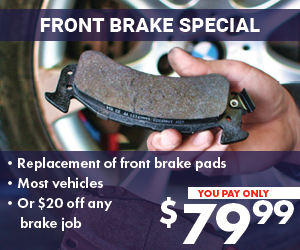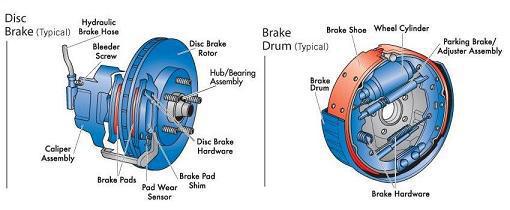Recent Posts
How Your Brakes Work
Certified Brake Repair and Lifetime Guarantee
- Brakes grinding or squeaking?
- Brake or ABS warning lights on?

Braking systems basics and How we can help you identify braking problems.
What Our Technicians Are Trained To Do
We inspect brake components and compare the results to manufacturers' specs. Recommendations are made per the Motorist Assurance Program Uniform Inspection Guidelines. Plus we offer a free inspection for most passenger and light trucks (up to 3/4 Ton).
Disc Brakes
- Disc brake rotors
- Disc brake pads
- Calipers
- Caliper hardware
Drum Brakes
- Brake drums
- Brake shoes
- Wheel cylinders
- Return springs & hardware
Hydraulic System
- Master cylinder
- Brake fluid
- Brake hoses/lines
- Power booster
Parking Brake
- Cables
- Adjustment
* Some parts include lifetime guarantees which cover free replacement for the life of the original vehicle for the original owner. Ask your sales adviser about your specific warranty.
How do brake pads work:
There's a lot more to effectively using your car's braking system then simply stomping on the pedal when a squirrel darts out in front of you. The braking systems of cars, trucks and motorcycles are made up of a number of parts that translate the driver's actions into physical force that stops the car. One of those brake parts is your vehicle's brake pads.
Brake pads are a key brake part because they are the component that contacts and applies pressure and friction to a vehicle's brake rotors -- those flat, shiny discs that you can sometimes see just behind the wheels of some vehicles. The pressure and friction applied to the brake rotor is what slows and stops the wheel. Once the wheels stop turning, the vehicle stops moving, too. Though the role of brake pads as braking parts is pretty simple, the brake pads themselves are anything but.
Because of how fast a vehicle's wheels rotate and how much a typical car or truck weighs, brake pads undergo extreme stress every time you slow down or come to a stop. Think about it: Would you want to grab and hold on to a heavy metal disc that was spinning really fast? Imagine slowly squeezing that disc until the vehicle rolls to a halt -- it's a thankless job, but brake pads do it repeatedly for thousands and thousands of miles without complaint.
How long do break pads last:
The lifespan of a given set of brake pads is dependent on a very wide set of variables ranging from personal driving style to the impersonal laws of physics. Mechanics and manufacturers have a loosely agreed upon mileage range from around 30,000 to 70,000 miles (48,280 to 112,654 kilometers), but stories of pads lasting a mere 100 miles (160.9 kilometers) to an astounding 100,000 miles (160,934 kilometers) abound.
These far-ranging numbers are understandable. Pads come in an array of types and compositions -- from composite to metallic to ceramic -- and are attached to an even more bewildering array of brake systems and rotors, all of which affect the life of the pad. Added to the mix are heat, pressure and friction in amounts that would astound most drivers. Indeed the brakes, especially the pads, are some of the hardest working components in your car.
For the purpose of this article we'll deal solely with brake pads, meaning the pads used in caliper brakes rather than drum brakes. The pads used in drum brakes are referred to as "shoes." They serve the same purpose and are often constructed of the same or similar material, but they function in a slightly different way.
Let's begin addressing the longevity question by looking at what brake pads are made of, or their frictional material. Pads generally come in four types: organic, semimetallic, metallic, and synthetic. Each of these types has their own characteristics that must be weighed against brake pad life:
Organic: Made from non-metallic fibers bonded into a composite material. The material is then treated with friction modifiers including graphite, powdered metals and even nutshells. Fillers are added to reduce noise and to affect heat transfer, among other factors.
Semimetallic: This pad is a mix of organic material and metals -- ranging from steel and iron to copper -- molded and bonded to form the pad. These pads are harder and more resistant to heat.
Metallic: This material, formed of a variety and mix of pressure bonded metals, was once used extensively in racing. Advances in organic and semimetallic pad composition have made metallic pads almost obsolete.
Synthetic: This is what is often referred to as ceramic pads. These pads are made from a composite of non-organic and nonmetallic material, usually fiberglass and aramid fibers. These pads weigh about half the weight of the average pad, they are stronger, have better cold and hot stopping power and they last much longer than the average pad. They also cost about twice as much.
For the pad materials above, the best stopping power is found in the organic pads. But this same stopping power means more of the pad material is worn away during a stop. Because of this, organic pads last the least amount of time on average. Semimetallic pads, the pads that are now on most cars, are harder and last longer but they don't stop as effectively as organic pads do. The same goes for ceramic pads, though these pads do often last longer if the driver is willing to pay the price and have a slightly longer stopping distance.
And as pads are all about stopping it's time to take a look at mass. The reality of mass or specifically stopping a given mass -- like a car -- brings us to the physics behind pad wear.
(source: http://auto.howstuffworks.com/auto-parts/brakes)




